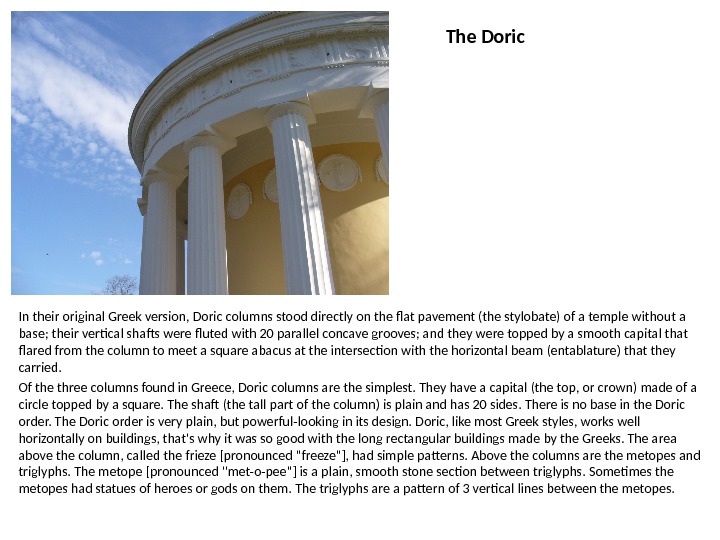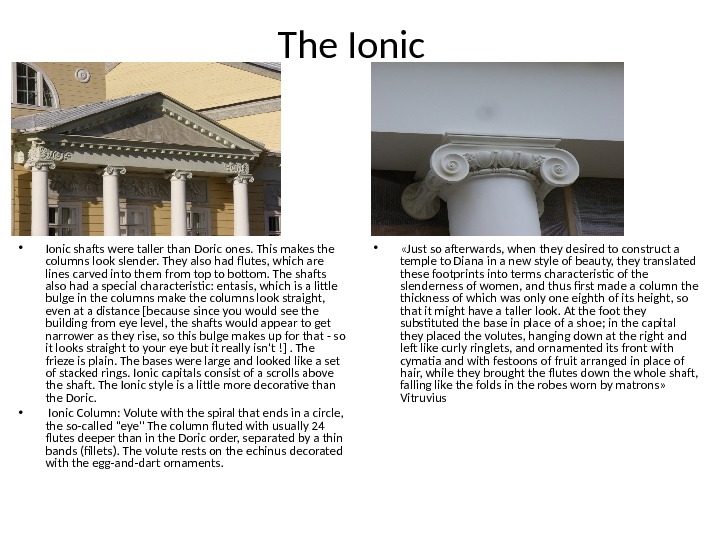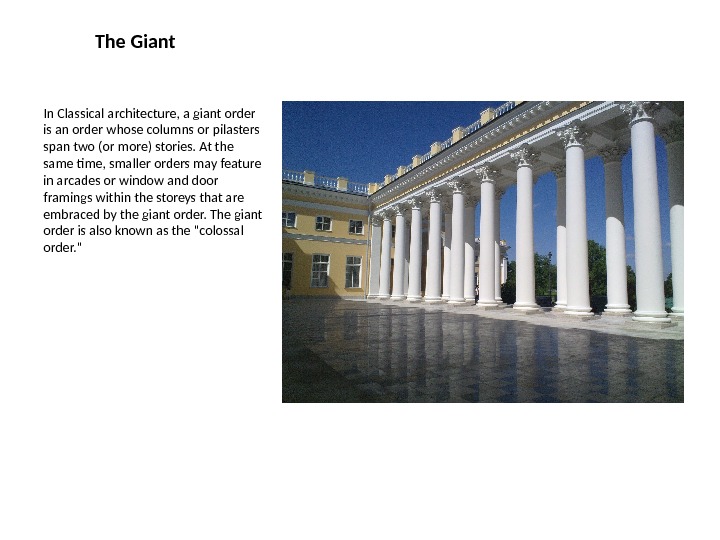ORDERS OF ARCHITECTURE The Doric In their








- Размер: 2.7 Mегабайта
- Количество слайдов: 8
Описание презентации ORDERS OF ARCHITECTURE The Doric In their по слайдам
 ORDERS OF ARCHITECTUR
ORDERS OF ARCHITECTUR
 The Doric In their original Greek version, Doric columns stood directly on the flat pavement (the stylobate) of a temple without a base; their vertical shafts were fluted with 20 parallel concave grooves; and they were topped by a smooth capital that flared from the column to meet a square abacus at the intersection with the horizontal beam (entablature) that they carried. Of the three columns found in Greece, Doric columns are the simplest. They have a capital (the top, or crown) made of a circle topped by a square. The shaft (the tall part of the column) is plain and has 20 sides. There is no base in the Doric order. The Doric order is very plain, but powerful-looking in its design. Doric, like most Greek styles, works well horizontally on buildings, that’s why it was so good with the long rectangular buildings made by the Greeks. The area above the column, called the frieze [pronounced «freeze»], had simple patterns. Above the columns are the metopes and triglyphs. The metope [pronounced «met-o-pee»] is a plain, smooth stone section between triglyphs. Sometimes the metopes had statues of heroes or gods on them. The triglyphs are a pattern of 3 vertical lines between the metopes.
The Doric In their original Greek version, Doric columns stood directly on the flat pavement (the stylobate) of a temple without a base; their vertical shafts were fluted with 20 parallel concave grooves; and they were topped by a smooth capital that flared from the column to meet a square abacus at the intersection with the horizontal beam (entablature) that they carried. Of the three columns found in Greece, Doric columns are the simplest. They have a capital (the top, or crown) made of a circle topped by a square. The shaft (the tall part of the column) is plain and has 20 sides. There is no base in the Doric order. The Doric order is very plain, but powerful-looking in its design. Doric, like most Greek styles, works well horizontally on buildings, that’s why it was so good with the long rectangular buildings made by the Greeks. The area above the column, called the frieze [pronounced «freeze»], had simple patterns. Above the columns are the metopes and triglyphs. The metope [pronounced «met-o-pee»] is a plain, smooth stone section between triglyphs. Sometimes the metopes had statues of heroes or gods on them. The triglyphs are a pattern of 3 vertical lines between the metopes.
 The Ionic • Ionic shafts were taller than Doric ones. This makes the columns look slender. They also had flutes, which are lines carved into them from top to bottom. The shafts also had a special characteristic: entasis, which is a little bulge in the columns make the columns look straight, even at a distance [because since you would see the building from eye level, the shafts would appear to get narrower as they rise, so this bulge makes up for that — so it looks straight to your eye but it really isn’t !]. The frieze is plain. The bases were large and looked like a set of stacked rings. Ionic capitals consist of a scrolls above the shaft. The Ionic style is a little more decorative than the Doric. • Ionic Column: Volute with the spiral that ends in a circle, the so-called «eye» The column fluted with usually 24 flutes deeper than in the Doric order, separated by a thin bands (fillets). The volute rests on the echinus decorated with the egg-and-dart ornaments. • « Just so afterwards, when they desired to construct a temple to Diana in a new style of beauty, they translated these footprints into terms characteristic of the slenderness of women, and thus first made a column the thickness of which was only one eighth of its height, so that it might have a taller look. At the foot they substituted the base in place of a shoe; in the capital they placed the volutes, hanging down at the right and left like curly ringlets, and ornamented its front with cymatia and with festoons of fruit arranged in place of hair, while they brought the flutes down the whole shaft, falling like the folds in the robes worn by matrons » Vitruvius
The Ionic • Ionic shafts were taller than Doric ones. This makes the columns look slender. They also had flutes, which are lines carved into them from top to bottom. The shafts also had a special characteristic: entasis, which is a little bulge in the columns make the columns look straight, even at a distance [because since you would see the building from eye level, the shafts would appear to get narrower as they rise, so this bulge makes up for that — so it looks straight to your eye but it really isn’t !]. The frieze is plain. The bases were large and looked like a set of stacked rings. Ionic capitals consist of a scrolls above the shaft. The Ionic style is a little more decorative than the Doric. • Ionic Column: Volute with the spiral that ends in a circle, the so-called «eye» The column fluted with usually 24 flutes deeper than in the Doric order, separated by a thin bands (fillets). The volute rests on the echinus decorated with the egg-and-dart ornaments. • « Just so afterwards, when they desired to construct a temple to Diana in a new style of beauty, they translated these footprints into terms characteristic of the slenderness of women, and thus first made a column the thickness of which was only one eighth of its height, so that it might have a taller look. At the foot they substituted the base in place of a shoe; in the capital they placed the volutes, hanging down at the right and left like curly ringlets, and ornamented its front with cymatia and with festoons of fruit arranged in place of hair, while they brought the flutes down the whole shaft, falling like the folds in the robes worn by matrons » Vitruvius
 The Corinthian order is the most decorative and is usually the one most modern people like best. Corinthian also uses entasis to make the shafts look straight. The Corinthian capitals have flowers and leaves below a small scroll. The shaft has flutes and the base is like the Ionian. Unlike the Doric and Ionian cornices, which are at a slant, the Corinthian roofs are flat.
The Corinthian order is the most decorative and is usually the one most modern people like best. Corinthian also uses entasis to make the shafts look straight. The Corinthian capitals have flowers and leaves below a small scroll. The shaft has flutes and the base is like the Ionian. Unlike the Doric and Ionian cornices, which are at a slant, the Corinthian roofs are flat.
 The Tuscan In the Tuscan order, the column had a simpler base and was unfluted, while both capital and entablature were without adornments. A plain astragal ringed the column beneath its plain cap. In its simplicity, it is seen as similar to the Doric order, and yet in its overall proportions and intercolumniation, it follows the ratios of the Ionic order. This strong order was considered most appropriate in military architecture and in docks and warehouses when they were dignified by architectural treatment.
The Tuscan In the Tuscan order, the column had a simpler base and was unfluted, while both capital and entablature were without adornments. A plain astragal ringed the column beneath its plain cap. In its simplicity, it is seen as similar to the Doric order, and yet in its overall proportions and intercolumniation, it follows the ratios of the Ionic order. This strong order was considered most appropriate in military architecture and in docks and warehouses when they were dignified by architectural treatment.
 The Composite The composite order is a mixed order, combining the volutes of the Ionic order capital with the acanthus leaves of the Corinthian order. The composite order volutes are larger, however, and the composite order also has echinus molding with egg-and-dart ornamentation between the volutes. The column of the composite order is ten diameters high. Grandest of the Roman Orders, essentially an ornate version of the eight-voluted Ionic capital known as the angular capital or Scamozzi Order under which are added two tiers of acanthus-leaves. Its entablature is also very ornate. It bears a resemblance to the Corinthian Order and is also called the Compound Order. The composite entablature uses the same common proportions as the Corinthian entablature. The elements of the cornice are delineated by five equal divisions. There is a cymatium (cyma recta) sitting at the top of the cornice and then the corona with its cyma reversa and smooth fascia. The most distinctive feature of the entablature is a dentil band placed below the cyma reversa. There is an ovolo below the dentils. A conge angles down into the higher moldings of the architrave. Below the moldings, there are two separate bands. The Composite order base uses one bead to separate the two scotias, while the Corinthian uses two beads. The lower scotia is also a little larger than the upper scotia. . The Composite capital contains an echinus and astragal set below the abacus. The abacus is made up of an ovolo, fillet, conge, and fascia. There is a cylindrical below the abacus. The lower part of the capital is adorned with two rows of acanthus leaves, similar to the Corinthian. Each pair of caulicoli located at the leaves’ second tier ends in a single bud or flower facing each other. Between the bud and the abacus, the astragal and echinus (with egg-and-dart motif) are placed. From the base of the abacus, the volutes continue down to sit on the second tier of leaves. Sprigs of honeysuckle are used to spring from the fillet of the volute, filling in the space next to the egg-and-dart. Above the echinus, each volute contains a fleuron which is usually leafier than the Corinthian version.
The Composite The composite order is a mixed order, combining the volutes of the Ionic order capital with the acanthus leaves of the Corinthian order. The composite order volutes are larger, however, and the composite order also has echinus molding with egg-and-dart ornamentation between the volutes. The column of the composite order is ten diameters high. Grandest of the Roman Orders, essentially an ornate version of the eight-voluted Ionic capital known as the angular capital or Scamozzi Order under which are added two tiers of acanthus-leaves. Its entablature is also very ornate. It bears a resemblance to the Corinthian Order and is also called the Compound Order. The composite entablature uses the same common proportions as the Corinthian entablature. The elements of the cornice are delineated by five equal divisions. There is a cymatium (cyma recta) sitting at the top of the cornice and then the corona with its cyma reversa and smooth fascia. The most distinctive feature of the entablature is a dentil band placed below the cyma reversa. There is an ovolo below the dentils. A conge angles down into the higher moldings of the architrave. Below the moldings, there are two separate bands. The Composite order base uses one bead to separate the two scotias, while the Corinthian uses two beads. The lower scotia is also a little larger than the upper scotia. . The Composite capital contains an echinus and astragal set below the abacus. The abacus is made up of an ovolo, fillet, conge, and fascia. There is a cylindrical below the abacus. The lower part of the capital is adorned with two rows of acanthus leaves, similar to the Corinthian. Each pair of caulicoli located at the leaves’ second tier ends in a single bud or flower facing each other. Between the bud and the abacus, the astragal and echinus (with egg-and-dart motif) are placed. From the base of the abacus, the volutes continue down to sit on the second tier of leaves. Sprigs of honeysuckle are used to spring from the fillet of the volute, filling in the space next to the egg-and-dart. Above the echinus, each volute contains a fleuron which is usually leafier than the Corinthian version.
 The Giant In Classical architecture, a giant order is an order whose columns or pilasters span two (or more) stories. At the same time, smaller orders may feature in arcades or window and door framings within the storeys that are embraced by the giant order. The giant order is also known as the «colossal order. «
The Giant In Classical architecture, a giant order is an order whose columns or pilasters span two (or more) stories. At the same time, smaller orders may feature in arcades or window and door framings within the storeys that are embraced by the giant order. The giant order is also known as the «colossal order. «
 The Renaissance period saw renewed interest in the ruins left by the ancient cultures of Greece and Rome, and the fertile development of a new architecture based on classical principles. The handbook De architectura by Roman writer, architect and engineer Vitruvius, is the only architectural writing that survived from Antiquity. Rediscovered in the 15 th century, Vitruvius was instantly hailed as the authority on classical orders and on architecture in general. Architects of the Renaissance and the Baroque periods in Europe based their rules on Vitruvius’ writings. What was added was rules for the use of the classical orders, and the exact proportions of the orders down to the most minute detail. Commentary on the appropriateness of the orders for temples devoted to particular deities (Vitruvius I. 2. 5) were elaborated by Renaissance theorists, to characterise the orders as bold and manly Doric, matronly Ionic, and maidenly Corinthian. The rules of the Renaissance and the Baroque periods came to be disregarded, and the original use of the orders revived, based on first-hand study of the ruins of classical antiquity — often hailed as the ‘correct’ use of the orders. Each period interpreted the orders in their own way. The architecture of every subsequent period of European architecture was based on the classical orders, until the late Victorian period when other influences first came into play.
The Renaissance period saw renewed interest in the ruins left by the ancient cultures of Greece and Rome, and the fertile development of a new architecture based on classical principles. The handbook De architectura by Roman writer, architect and engineer Vitruvius, is the only architectural writing that survived from Antiquity. Rediscovered in the 15 th century, Vitruvius was instantly hailed as the authority on classical orders and on architecture in general. Architects of the Renaissance and the Baroque periods in Europe based their rules on Vitruvius’ writings. What was added was rules for the use of the classical orders, and the exact proportions of the orders down to the most minute detail. Commentary on the appropriateness of the orders for temples devoted to particular deities (Vitruvius I. 2. 5) were elaborated by Renaissance theorists, to characterise the orders as bold and manly Doric, matronly Ionic, and maidenly Corinthian. The rules of the Renaissance and the Baroque periods came to be disregarded, and the original use of the orders revived, based on first-hand study of the ruins of classical antiquity — often hailed as the ‘correct’ use of the orders. Each period interpreted the orders in their own way. The architecture of every subsequent period of European architecture was based on the classical orders, until the late Victorian period when other influences first came into play.
